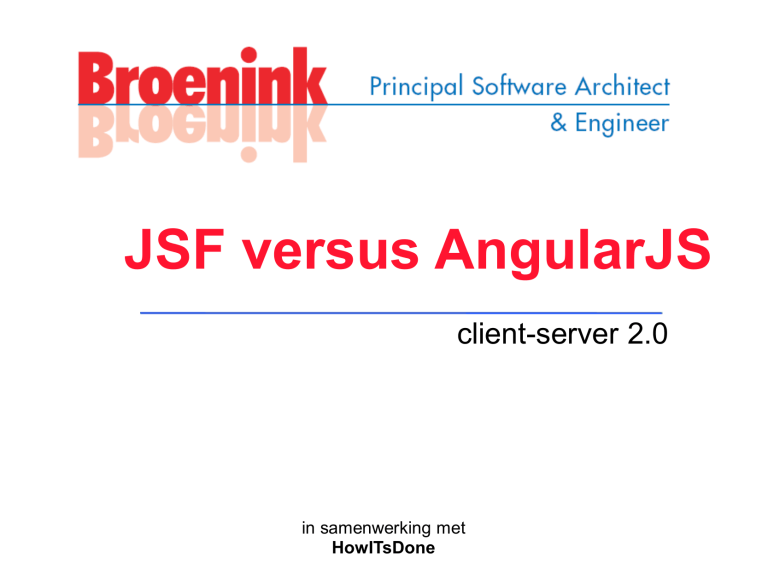
JSF versus AngularJS
client-server 2.0
in samenwerking met
HowITsDone
Geschiedenis JSF
•
•
•
•
•
•
Java Servlet specificatie: HTML in code
JSP: HTML template
Struts: MVC framework
JSF: verbeterde Struts
Facelets: verbeterde JSP
JSF 2.0: facelets de default
Geschiedenis gebruik JavaScript
• Browser HTML redelijk browser onafhankelijk
• Browser JavaScript niet echt browser
onafhankelijk
• JavaScript DOM API browser onafhankelijk
• JQuery 2006
• Desktop like GUI
• Dojo 2004, Backbase, …
• MVC/ MVVM/ MVP
• Backbone, Knockout, GWT, AngularJS, …
• RESTful JSON client-server protocol
JSF voorbeeld (1)
<?xml version="1.0" encoding="UTF-8"?>
<!DOCTYPE html PUBLIC "-//W3C//DTD XHTML 1.0 Transitional//EN" "http://www.w3.org/TR/xhtml1/DTD/xhtml1transitional.dtd">
<html xmlns="http://www.w3.org/1999/xhtml" xmlns:h="http://java.sun.com/jsf/html"
xmlns:ui="http://java.sun.com/jsf/facelets" >
<h:head>
<title>Boeken</title>
<h:outputStylesheet name=“boek.css" library="css" />
</h:head>
<h:body>
<div id="header">
<ui:insert name="header" >
<ui:include src="/template/common/commonHeader.xhtml" />
</ui:insert>
</div>
<div id="content">
<ui:insert name="content" >
<ui:include src="/template/common/commonContent.xhtml" />
</ui:insert>
</div>
<div id="footer">
<ui:insert name="footer" >
<ui:include src="/template/common/commonFooter.xhtml" />
</ui:insert>
</div>
</h:body>
</html>
JSF voorbeeld (2)
<html xmlns="http://www.w3.org/1999/xhtml" xmlns:ui="http://java.sun.com/jsf/facelets" >
<body>
ALL TAGS ABOVE THIS LINE AND THIS LINE WILL BE REMOVED BY JSF
<ui:composition>
<h1>This is default header</h1>
</ui:composition>
ALL TAGS BELOW THIS LINE AND THSI LINE WILL BE REMOVED BY JSF
</body>
</html>
JSF voorbeeld (3)
<html xmlns="http://www.w3.org/1999/xhtml" xmlns:h="http://java.sun.com/jsf/html"
xmlns:ui="http://java.sun.com/jsf/facelets" >
<body>
<ui:composition template="/template/common/commonLayout.xhtml">
<ui:define name="content">
<h2>Voeg boek toe</h2>
<h:form>
<div class="veld">
<h:outputLabel value="Titel"/>
<h:inputText value="#{boekHandler.boek.titel}"/>
</div>
<h:commandButton action="#{boekHandler.voegToe}“ value=“Voeg toe”/>
</h:form>
</ui:define>
</ui:composition>
</body>
</html>
JSF voorbeeld (4)
@Named
@RequestScoped
public class BoekHandler {
@Inject
BoekRepository boekRepository;
@TransactionAttribute(REQUIRES_NEW)
@RolesAllowed(“klant")
public void voegToe() {
...
}
public Boek getBoek() {
…
}
}
JSF voorbeeld (5)
web.xml
<context-param>
<param-name>javax.faces.PROJECT_STAGE</param-name>
<!-- <param-value>Production</param-value> -->
<param-value>Development</param-value>
</context-param>
<context-param>
<param-name>javax.faces.STATE_SAVING_METHOD</param-name>
<param-value>server</param-value>
</context-param>
<context-param>
<param-name>com.sun.faces.writeStateAtFormEnd</param-name> <!-- workaround bug JSF -->
<param-value>false</param-value>
</context-param>
<servlet>
<servlet-name>Faces Servlet</servlet-name>
<servlet-class>javax.faces.webapp.FacesServlet</servlet-class>
</servlet>
<servlet-mapping>
<servlet-name>Faces Servlet</servlet-name>
<url-pattern>*.xhtml</url-pattern>
</servlet-mapping>
<session-config>
<session-timeout>30</session-timeout>
</session-config>
JSF architectuur
Pagina (HTTP GET)
• (kies en bewaar view) Facelet -> HTML
Submit (HTTP POST)
• Bouw view op (uit serialized string)
• Verwerk submitted data
• Valideer submitted data
• Copieer submitted data naar Backing Bean
• Call action methode in Backing Bean
• (kies en bewaar volgende view) Facelet ->
HTML
AngularJS
Waarom AngularJS?
• Open Source
• Google (kennis, kunde, commitment)
• Samenwerking met W3C
• Volledig en duidelijk
•
•
•
•
•
Single page (AJAX) + deep linking
Rich widgets
Simpele concepten en code
Goede documentatie
Stabiel
• Populair
• Zelf HTML tags maken (is dit wel handig?)
AngularJS voorbeeld (1)
<!doctype html>
<html ng-app=“boekMVC”>
<head>
<meta charset="utf-8">
<title>Boeken</title>
<link rel="stylesheet" href=“css/boek.css">
</head>
<body>
<section ng-controller=“boekController">
<header>
<h1>Voeg boek toe</h1>
<form ng-submit="addBoek()">
<label>Titel</label>
<input placeholder=“Titel" ng-model=“boekTitel">
<input type=“submit” value=“Voeg toe”/>
</form>
</header>
</section>
<script src="js/libs/angular/angular.js"></script>
<script src="js/boek.js"></script>
</body>
</html>
AngularJS voorbeeld (2)
// boek.js
var boekMVC = angular.module(‘boekMVC', []);
boekMVC.controller(‘boekController', function boekController( $scope ) {
$scope.boekTitel = "";
$scope.voegToe = function() {
… HTTP POST $scope als json op url /json/voegtoe
}
}
AngularJS voorbeeld (3)
web.xml
<servlet>
<servlet-name>spring-json</servlet-name>
<servlet-class>org.springframework.web.servlet.DispatcherServlet</servlet-class>
<init-param>
<param-name>contextConfigLocation</param-name>
<param-value>classpath:spring/spring-json-servlet.xml</param-value>
</init-param>
</servlet>
<servlet-mapping>
<servlet-name>spring-json</servlet-name>
<url-pattern>/json/*</url-pattern>
</servlet-mapping>
AngularJS voorbeeld (4)
spring-json-servlet.xml
<!-- Configures support for @Controllers -->
<context:component-scan base-package="nl.mycompany.myapp.web.json" />
<bean class="org.springframework.web.servlet.view.ContentNegotiatingViewResolver">
<property name="order" value="1" />
<property name="mediaTypes">
<map>
<entry key="json" value="application/json" />
</map>
</property>
<property name="defaultViews">
<list>
<ref bean="jsonView" />
</list>
</property>
</bean>
<bean id="jsonView“ class="org.springframework.web.servlet.view.json.MappingJacksonJsonView" />
<mvc:annotation-driven />
AngularJS voorbeeld (5)
@Controller
public class BoekController {
@RequestMapping(value = "/voegtoe")
public void voegToe( @RequestParam(“boekTitel") String boekTitel) {
…
}
}
AngularJS architectuur
http://code.angularjs.org/1.0.5/doc
s/guide/concepts
The browser loads the HTML and parses it into
a DOM
The browser loads angular.js script
Angular waits for DOMContentLoaded event
Angular looks for ng-app directive, which
designates the application boundary
The Module specified in ng-app (if any) is used
to configure the $injector
The $injector is used to create
the $compileservice as well as $rootScope
The $compile service is used to compile the
DOM and link it with $rootScope
The {{name}} interpolates the expression
toHello World!
Vergelijking JSF - AngularJS
• Runtime architectuur
• JSF: UI verdeeld over client en server
• AngularJS: client-server 2.0
• zero install (initieel komt UI van server)
• UI draait op client device; data interface met server
• Ontwikkelarchitectuur UI
• JSF UI: heterogeen
• ‘server-talen’: Java, HTML, Facelet
• browser-talen: HTML, JavaScript, CSS
• AngularJS UI: eenduidig
• alleen browser talen: HTML5, JavaScript, CSS, Angular API
• Ontwikkelarchitectuur server-side
• JSF: JSF (in combi met andere JEE API’s of Spring)
• AngularJS: Servlet + JSON framework + SpringMVC
(in combi met andere JEE API’s of Spring)
Keuze criteria
•
•
•
•
•
•
•
•
•
•
•
Andere devices
Browser independent
Performance client
Performance server (JSF: view save/restore; HTML
gen.)
Schaalbaar (JSF: session state: sticky session LB)
Cloud (aantal opties; client / server ontkoppeling)
Bestaande kennis en kunde ontwikkelteam
Ease of development, learning curve
Build-Test-Package-Deploy (hotfix)
Continuus Integration & Delivery
Onderhoudbaarheid (SMART maken)
Nogmaals vergelijking
criterium
andere devices
weging JSF
2
3
Angular toelichting
JS
5
Beide geen native support (IOS/ Android)
JS zit dichter op HTML5 mogelijkheden
